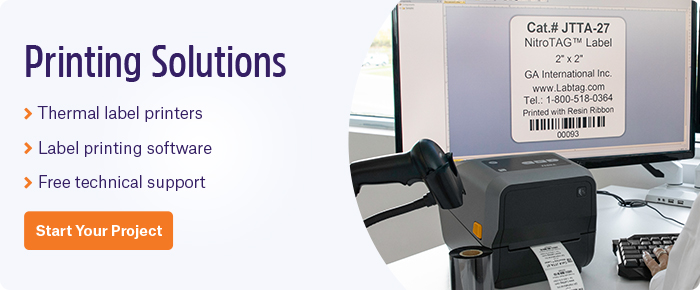![]()
Sample tracking in the laboratory can be optimized by implementing cloud-based laboratory information management systems (LIMS) and inventory management systems alongside barcode and/or RFID labels. Utilizing labels designed for specific laboratory environments, these automated tracking systems provide a nearly fool-proof way of tracking and tracing samples across experimental workflows, irrespective of their storage location and processing technique. Here are some practical tips to employ while using these automated systems to help design error-mitigating SOPs and keep your samples safe.
Standardize barcodes and naming conventions
When an automated tracking system is first implemented, it’s essential to immediately standardize which barcode will be used in addition to all naming conventions used when printing human-readable text on labels and for the databases that track and store information about your samples.
Many types of barcodes are available, so it’s crucial to identify the solution most appropriate for your lab.
- 1D barcodes: Read in a sequence from left to right, 1D barcodes can encode between 20-25 characters. Because of the shape of these barcodes, space can sometimes be an issue. Examples of 1D barcodes include UPC code, Code 128, PDF417, and the GS1 databar. Of these, PDF417 and GS1 databar are capable of encoding the most information for a 1D barcode but often take up a lot of space.
- 2D barcodes: These barcodes are organized both horizontally and vertically, forming a readable square. They can encode up to 2000 characters while taking up much less space than 1D barcodes and can be scanned in any orientation. Moreover, these barcodes have more built-in redundancy, making them more resilient to damage than traditional 1D barcodes. Common examples of 2D barcodes include the QR code, Data Matrix, and Aztec code. QR codes are generally considered a versatile, all-purpose 2D barcode, useful for asset tracking and inventory management. Data Matrix, with their ability to be scaled down to tiny sizes, are extremely useful for labeling smaller items, like PCR tubes. Aztec codes are specialized in that they lack a quiet zone, taking up less space than other 2D barcodes. They can also be easily decoded if their resolution is poor.
When it comes to barcode standardization, it is essential to ensure that quality remains consistent. Barcode grading allows users to verify that all barcodes are generated error-free. Devices like the TruChek Omni™ scan for multiple barcode variables, like contrast and spatial parameters, and provide a grade to each barcode, ensuring each one is of high enough quality to be used accurately and consistently.
Capture appropriate metadata
In order for all users to fully understand the nature of the work being performed, it is essential to collect detailed data regarding the nature of each sample. This helps others assess the context of your work and makes it possible to perform a meaningful analysis later. Collecting metadata will also make it possible for others in your lab to glean inventories and determine the location, volume, and nature of samples and reagents.
Some details that should be recorded include:
- Name of the sample
- Name of the collection/experiment it belongs to
- Name of the individual who last manipulated the sample
- Location of the sample
- Date of procession
- Sample volume
- Composition of the sample (i.e., list of cell types and buffers used)
- History of assays carried out on the sample
- Unique sample ID (if available)
Employ a backup
It’s likely that out of the thousands of samples, your lab may process every day, issues may occur with scanning a few. However, just a few misread samples can be the difference between success and failure, which can make trying to even comprehend a result much more difficult when the identity of the samples is in question. With that in mind, a backup method for tracking samples is always recommended in case one protocol fails.
If barcodes are the primary tracking method, serialization and/or human-readable text represent an excellent secondary means of tracking the samples. Barcodes can also be combined with RFID to provide a two-pronged tracking method. Recent technological advances have made this possible as nearly any label can now be outfitted with an RFID inlay, allowing RFID to be used wholesale throughout the lab, regardless of application. Barcodes can also be printed simultaneously on RFID labels, providing a secondary means of tracking samples should the RFID reader fail to detect a signal.
LabTAG by GA International is a leading manufacturer of high-performance specialty labels and a supplier of identification solutions used in research and medical labs as well as healthcare institutions.




